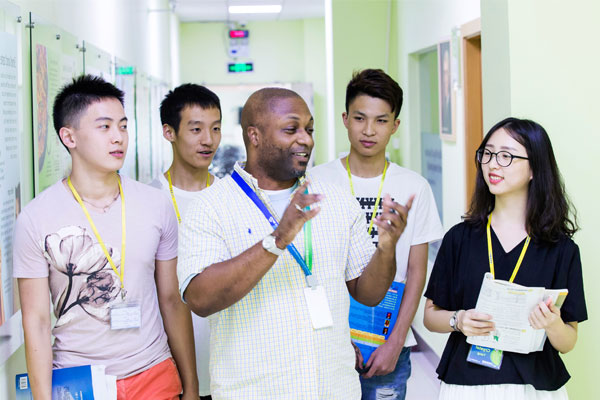清华新闻网5月15日电 (记者 李含)5月15日下午,在华访问的印度总理纳伦德拉·莫迪来到清华大学,做客清华大学海外名师讲堂发表演讲,与清华学生进行了互动交流。中国外交部长王毅出席演讲会。清华大学校长邱勇在演讲前与莫迪进行了简短会谈。中国驻印度大使乐玉成陪同来访。清华大学校长助理、生命科学学院院长施一公参加会谈。
下午4时,莫迪总理乘车来到清华大学主楼。一身灰色着装的莫迪总理与几名印度留学生代表一一握手、亲切交流。
在会谈中,邱勇代表清华大学,对莫迪总理到访表示欢迎,并简要介绍了学校近期发展情况及与印度高校的合作情况。双方表示,将进一步推进清华大学与印度高校和研究机构的交流与合作。
随后,莫迪总理来到主楼报告厅发表演讲。邱勇主持演讲会。他说,中国和印度两国人民友谊源远流长。欢迎更多的印度优秀青年和学者来到清华大学,也期待有更多的清华学子和教师前往印度学习、交流。
莫迪总理在演讲开始首先用中文向现场300多位同学和中印嘉宾问好,他说,“很高兴来到著名的清华大学”,并幽默地询问自己说中文好不好。现场对此报以持久热烈的掌声。他表示,之所以选择在清华大学演讲,因为只有年轻人才能够承继两国的未来,承担两国合作的责任。
他说,中国有句古话“一年之计,莫如树谷;十年之计,莫如树木;终身之计,莫如树人”。印度也有相同的说法“财富的增长源于给予,财富就是知识,高于一切身外之物”。印中两国从古至今就有着相似的文化与智慧。
莫迪指出,这个时代最显著的变化就是印中两国的复兴。这两个世界上人口最多的国家正在经历史上前所未有的大规模和快速的经济和社会变革。中国在过去三十年中取得的成功已经改变了全球经济的特征。印度现已成为经济革命的最新前沿。他说,在很多方面,我们两国都反映出相同的愿景,拥有相似的挑战和相同的机遇。彼此的成功能够给对方以启发。他说,如果我们两国发出同样的声音,亚洲的声音会更强。简单来说21世纪将会成为亚洲世纪,这在很大程度上取决于我们每个国家怎样做,以及印中两国如何合作。
莫迪总理还在演讲中表示,印度决定向中国公民开放电子游客签证。他说,我们即将庆祝2015中印交流年。今天,我们就将启动省级和州级领导人论坛。
展望未来,莫迪总理说,不仅我们的梦想是互通的,两国的未来也是深深的相互依存。印度和中国是两个值得骄傲的文明大国,两国必将圆满完成既定目标。他说,只有我们携手共进,坚持互信,步调统一,才能使我们发展的道路更加顺利,我们的未来也会更加光明!
印度总理莫迪在清华大学英语演讲稿全文(视频+双语演讲稿)
Qiu Yong, President of Tsinghua University,
Foreign Minister Wang Yi,
Shi Yigong, Assistant President of Tsinghua University,
I am truly delighted to be at the Tsinghua University today.
You are a world class institution. You are a symbol of success of China’s education sector.
You are the foundation for China’s economic miracle. You have produced great leaders, including President Xi.
It is not surprising that China’s economic growth and its new leadership in research, science and technology have taken place together.
I particularly like the old Chinese saying, If you think in terms of a year, plant a seed; if you think in terms of ten years, plant trees; if you think in terms of 100 years, teach the people.
In India, too, the ancient saying is vyaye krate vardhate eva nityam, vidhya dhanam sarva dhan pradhanam
The wealth that increases by giving, That wealth is knowledge and is supreme of all possessions.
This is one example of how our two nations are united in their timeless wisdom.
There is much more, though, that links our two ancient civilizations.
I began my journey in China in Xian. In doing so, I retraced the footsteps of the Chinese monk Xuanzang.
He travelled to India from Xian in the seventh century in search of knowledge and returned to Xian as a friend and chronicler of India.
President Xi’s visit in India last September started from Ahmedabad. It is not far from Vadnagar, my birthplace, but important, because it hosted Xuanzang and many pilgrims from China.
The world’s first large scale educational exchange programme took place between India and China during the Tang Dynasty.
Records talk of about 80 Indian monks coming to China and nearly 150 Chinese monks returning after their education in India. And yes, this was in the 10th and 11th century.
Mumbai’s rise as a port and a shipbuilding centre is because of cotton trade with China.
And, those who love silk and textiles know that India’s famous tanchoi sarees owe themselves to three brothers from my state of Gujarat who learnt the art of weaving from Chinese masters in the 19th century.
And, in an unquestionable evidence of our ancient trade, silk in our classical Sanskrit language is called Cinapatta.
So, the centuries-old story of our relations has been of spiritualism, learning, art and trade.
It is a picture of respect for each other’s civilisation and of shared prosperity.
It is reflected in the human values of Dr. Dwarkanath Kotnis, a doctor from India, who treated soldiers in China during the Second World War.
Today, after difficult and sometimes dark passages of history, India and China stand at a rare moment of vast and multiple transitions in the world.
Perhaps, the most significant change of this era is the re-emergence of China and India.
The world’s two most populous nations are undergoing economic and social transformation on a scale and at a speed that is unmatched in history.
China’s success over the past three decades has changed the character of the global economy.
India is now the next frontier of the economic revolution.
We have the demography for it. About 800 million people in India are below the age of 35 years. Their aspirations, energy, enterprise and skills will be the force for India’s economic transformation.
We now have the political mandate and the will to make it happen.
Over the past year, we have moved with a clear and coherent vision. And, we have acted with speed, resolve and boldness to implement it.
We have taken sweeping steps to reform our policies and open up more to foreign direct investments. This includes new areas like insurance, construction, defence and railways.
We are eliminating unnecessary regulations and simplifying our procedures. We are using digital technology to eliminate multiple approvals and endless wait.
We are building a tax regime that is predictable, stable and competitive, and that will integrate the Indian market.
We are scaling up investments in next generation infrastructure – roads, ports, railways, airports, telecom, digital networks and clean energy.
Our resources are being allocated with speed and transparency. And, we will make sure that land acquisition does not become a barrier to growth or a burden on farmers.
We are creating the global skill pool to establish a modern economy with a world class manufacturing sector.
We are reviving our agriculture sector to restore the fortunes of our farmers and boost our growth.
Like China, urban renewal is both a necessity and a means to add energy to our economy.
We are combining traditional strategies with modern economic instruments to eliminate poverty and create security for the poor.
We have launched major schemes on financial inclusion of all, providing funds to the un-banked, and ensuring efficient and direct transfer of benefits to the poor.And, we are ensuring that insurance and pension schemes reach the poorest.
We have set time bound goals for providing access to housing, water and sanitation for all.
This won’t just transform lives, but also generate a new source of economic momentum.
Above all, we are changing the way we govern ourselves – not just in the way we work in New Delhi, but also in the way we work together with state governments, districts and cities.
Because we know, as you do, that our vision may be formed in Delhi, but our success will be determined by state capitals.
That is why I am here today with two Chief Ministers, which is a new aspect of our foreign policy. And, for the first time for India, Premier Li and I will sit with provincial leaders and chief ministers to discuss our partnership.
I know that rewriting policies can be easier than changing mindsets and work culture. But, we are on the right path.
You will feel the change in India. And, you can see it in our growth rate. It has now increased to 7.5%, and we are encouraged by international experts speak in one voice of higher growth rates.
In many ways, our two countries reflect the same aspirations, similar challenges and the same opportunities.
We can be inspired by each other’s successes.
And, in the global uncertainties of our times, we can reinforce each other’s progress.
Perhaps, no other economy in the world offers such opportunities for the future as India’s. And, few partnerships are as filled with promise as ours.
During President Xi’s visit last September, we set for ourselves a new level of ambition for our cooperation.
Partnership in modernizing Indian railways, two Chinese industrial parks in India, commitments of 20 billion dollars in investments into India over the next five years partnership in our Make in India Mission: This is the shape of our future.
Tomorrow in Shanghai, we will see the agreements on first of those partnerships between our industries.
But, to maintain this partnership over the long run, we must also improve the access of Indian industry to the Chinese market. I am encouraged by President Xi’s and Premier Li’s commitment to resolve this problem.
As much as our bilateral cooperation, our international partnership will be important for each other’s success.
Our changing world has created new opportunities and challenges.
We both face instability in our shared neighbourhood that can threaten our security and slow down our economies.
The spreading tide of extremism and terrorism is a threat we both face; for both, its source is in the same region.
We must also deal with the changing character of terrorism that has made it less predictable and more diffuse.
We source a large part of our energy from the same region that faces instability and uncertain future.
India and China conduct their international commerce on the same sea lanes. The security of sea lanes is vital for our two economies; and, our cooperation is essential to achieve it.
Equally, we both seek to connect a fragmented Asia. There are projects we will pursue individually. There are few such as the Bangladesh, China India Myanmar Corridor that we are doing jointly.
But, geography and history tell us that the dream of an interconnected Asia will be successful, when India and China work together.
We are two countries that have gained a lot from an open, rule-based global trading system. Equally, we have most to lose if it breaks down.
We both have enormous stakes in the international negotiations on climate change. Our cooperation in these forums will be crucial to shape their outcomes.
Today, we speak of Asia’s resurgence. It is the result of the rise of many powers in the region at the same time.
It is an Asia of great promise, but also many uncertainties.
Asia’s re- emergence is leading to a multi-polar world that we both welcome.
But, it is also an unpredictable and complex environment of shifting equations.
We can be more certain of a peaceful and stable future for Asia if India and China cooperate closely.
A resurgent Asia is seeking a bigger voice in global affairs. India and China seek a greater role in the world. It may be reforms in the United Nations Security Council or the new Asian Infrastructure Investment Bank.
But, Asia’s voice will be stronger and our nation’s role more influential, if India and China speak in one voice – for all of us and for each other.
Simply put, the prospects of the 21st century becoming the Asian century will depend in large measure on what India and China achieve individually and what we do together.
The rising fortunes of 2.5 billion pairs of joined hands will be of the greatest consequence for our region and the humanity.
This is the vision that I share with President Xi and Premier Li.
This is the impulse that is driving our relationship.
In recent years, we have deepened our political engagement. We have kept our borders peaceful. We have managed our differences and not allowed them to impede closer cooperation. We have enhanced our cooperation across the full spectrum of our relationship.
Yet, if we have to realise the extraordinary potential of our partnership, we must also address the issues that lead to hesitation and doubts, even distrust, in our relationship.
First, we must try to settle the boundary question quickly.
We both recognise that this is history’s legacy. Resolving it is our shared responsibility to the future. We must move ahead with new purpose and determination.
The solution we choose should do more than settle the boundary question.
It should do so in a manner that transforms our relationship and not cause new disruptions.
We have been remarkably successful in maintaining peace and tranquility along the border.
We must continue to do that on the principle of mutual and equal security.
Our agreements, protocols and border mechanisms have been helpful.
But, a shadow of uncertainty always hangs over the sensitive areas of the border region.
It is because neither side knows where the Line of Actual Control is, in these areas.
That is why I have proposed resuming the process of clarifying it. We can do this without prejudice to our position on the boundary question.
We should think of creative solutions to issues that have become irritants – from visa policies to trans-border rivers.
Sometimes, small steps can have a deep impact on how our people see each other.
We are both increasing our engagement in our shared neighbourhood. This calls for deeper strategic communication to build mutual trust and confidence.
We must ensure that our relationships with other countries do not become a source of concern for each other. And, wherever possible and feasible, we should work together, as we did in responding to the earthquake in Nepal.
If the last century was the age of alliances, this is an era of inter-dependence. So, talks of alliances against one another have no foundation.
In any case, we are both ancient civilizations, large and independent nations. Neither of us can be contained or become part of anyone’s plans.
So, our partnership in international forums should not be determined by the concerns of others, but the interests of our two countries.
China’s support for India’s permanent membership of a reformed UN Security Council, and for India’s membership of export control regimes like Nuclear Suppliers Group will do more than just strengthen our international cooperation.
It will take our relationship to a new level.
It will give Asia a stronger voice in the world.
If we are able to deepen mutual trust and confidence, we will also be able to reinforce each other’s efforts of connecting Asia with itself and rest of the world.
Our soldiers face each other on the border, but we should also deepen our defence and security cooperation to address our many common challenges.
Above all, as we look ahead, we must build more bridges of familiarity and comfort between our people.
About 33% of the world’s population is either Indian or Chinese. Yet, our people know very little of each other.
We must seek inspiration from the pilgrims of the ancient times, who braved the unknown in search of knowledge, and enriched us both.
So, we have decided to extend electronic tourist visas to Chinese nationals. We are celebrating the “Year of India” in China in 2015. We are launching the ‘Provincial and State Leaders Forum’ today.
Later today, we will have the Yoga-Taichi event. It will represent the coming together of our two civilizations.
We are starting the Gandhi and India Study Centre in Fudan University and a college of Yoga in Kunming.
The second route to Kailash Mansarovar for Indian pilgrims will start in June, for which I want to thank President Xi.
These are just some of the many steps India and China are taking to bring the world’s two largest populations in closer contact.
For this reason, I chose to speak today at a university.
Because it is the youth that will inherit the future of our countries and the responsibility for our relationship.
President Xi has spoken eloquently about the inter-connected dreams of China and India and the new type of relationship between major countries.
Not only are our dreams inter-connected, our future is also deeply inter- connected.
We are at a moment, when we have the opportunity to make our choices.
India and China are two proud civilizations and two great nations that will fulfill their destinies.
We each have the strength and the will to choose our own paths to success.
But, we have the ancient wisdom to know that our journey will be smoother and our future brighter, when we will walk together, confident of one another, and in step with each other.
Thank you very much and thanks for your invitation, thanks a lot.
本文链接:http://www.phenglish.cn/oral/2016-11-25/98.html
 名中外教,打造国际文化氛围!
名中外教,打造国际文化氛围!







